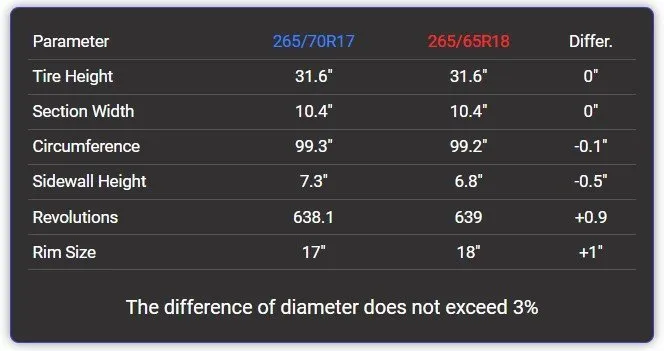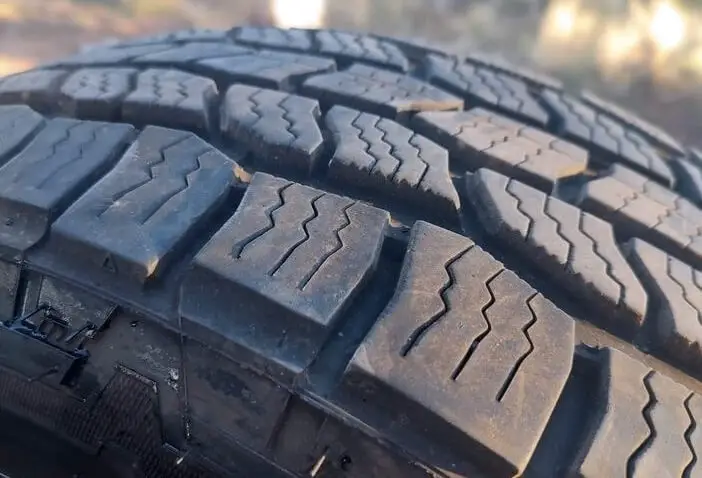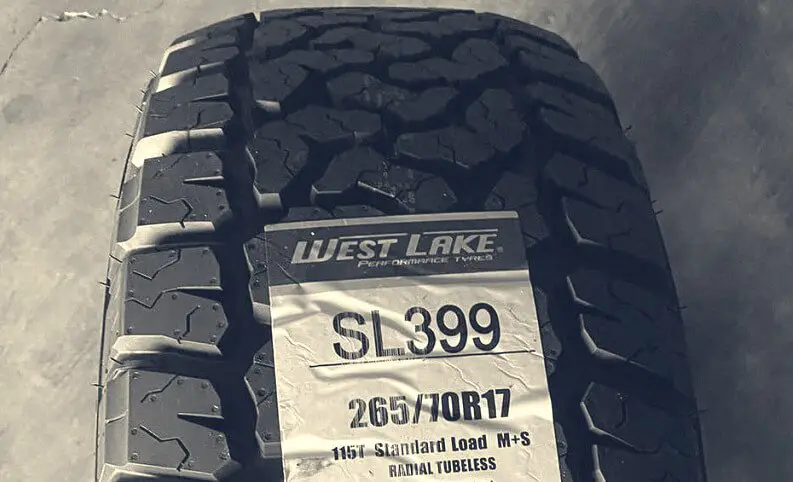Tire Size 265/70r17 vs 265/65r18

Can you switch from 265/70R17 to 265/65R18 tires? The short answer is yes. These tire sizes are close enough in overall diameter to be interchangeable in most cases without major issues. However, there are some differences to be aware of.
- Overall diameter difference is only -0.1%, well within acceptable range
- 265/65R18 tires have a 0.52 inch shorter sidewall than 265/70R17
- Ride may be slightly firmer but handling may feel more responsive
- 265/65R18 gives a sportier look with the larger wheel and lower profile
265 70r17 vs 265 65r18 Table
By referring to this comparison table, you can gain insight into the distinctions.

Fitment Guide
In this case, 265/70R17 tires have a diameter of 31.61 inches (802.8 mm) while 265/65R18 tires have a diameter of 31.56 inches (801.7 mm).
The difference is only -0.1%, well within the acceptable range. This means 265/65R18 tires can be safely used in place of 265/70R17 in most applications.
On-Road Impact
Switching to a tire with a shorter sidewall can have various impacts on on-road performance. Let’s take a closer look at what you might notice with 265/65R18 tires vs 265/70R17:
- Ride Comfort: Tires with shorter sidewalls tend to have a slightly firmer ride. The 0.52 inch shorter sidewall of the 265/65R18 tires provides less cushioning, so you may feel bumps and irregularities in the road a bit more. However, many drivers find the difference barely noticeable.
- Handling: The shorter, stiffer sidewall of 265/65R18 tires can provide crisper steering response and more precise handling. You may find that your vehicle feels a little more agile and responsive to steering inputs. The tradeoff is slightly less compliance over rough surfaces.
- Speedometer Accuracy: Speedometer readings can be thrown off by changes in tire size. However, the difference between these sizes is only 0.1%, so speedo error will be minimal – less than 0.03 mph at 20 mph. You likely won’t notice any difference.
- Gas Mileage: In theory, the 265/65R18 tires will yield slightly better gas mileage due to lower rolling resistance from the shorter sidewalls. In the real world, you probably won’t perceive the tiny 0.1% difference in revolutions per mile. Other factors like tire pressure, driving habits, and road conditions have a much bigger impact on fuel economy.
- Aesthetics: Many people prefer the look of larger wheels with lower profile tires. The 265/65R18 size, being one inch taller and having a shorter sidewall, can give your vehicle a sportier, more aggressive appearance vs the 265/70R17. Looks are subjective though, so it comes down to your personal taste.

Off-Road Impact
If you venture off the beaten path, there are other factors to consider when going from 265/70R17 to 265/65R18 tires. The shorter sidewall can affect off-road performance in a few key ways:
- Ground Clearance: The 0.04 inch reduction in overall tire diameter with 265/65R18 tires is negligible for ground clearance. You’d be hard pressed to notice a difference in real-world off-road situations. If you’re worried, you can always add a small suspension lift to compensate.
- Durability: Taller sidewalls are better able to absorb hard impacts from obstacles like rocks and logs. The shorter 265/65R18 sidewall offers less cushioning, so you’ll have to be a bit more careful about what you drive over. With proper tire pressures and driving technique though, you can still tackle most terrain.
- Traction: In loose surfaces like mud and sand, the taller 265/70R17 sidewall can provide a larger contact patch for better flotation and traction. The 265/65R18 may be more prone to sinking and spinning. Proper aired down pressures become even more important.
- Protection: More sidewall rubber between your wheel and the trail means more protection from rock rash and hard hits that could damage the rim. While going from 265/70R17 to 265/65R18 only removes 0.52 inches of sidewall, that could make a difference in extreme off-road scenarios. Aftermarket wheels with more backspacing can help offset this.

What is the Main Difference Between 265/70R17 and 265/65R18?
The primary difference between a 265/70R17 and 265/65R18 tire is the sidewall height.
The 265/65R18 has a sidewall that is 0.52 inches shorter than the 265/70R17, due to the larger 18 inch wheel diameter. This reduces the tire’s overall diameter by 0.04 inches.
Can I Use 265/65R18 Instead of 265/70R17?
Yes, in most cases you can use 265/65R18 tires instead of 265/70R17. The 0.1% difference in overall diameter is well within the recommended 3% range for tire substitution.
The shorter sidewall may slightly impact ride and off-road performance but is generally compatible.
How Much Taller Is a 265/70R17 Tire Than a 265/65R18?
A 265/70R17 tire is 0.04 inches taller in overall diameter than a 265/65R18 tire.
The 265/70R17 measures 31.61 inches in diameter, while the 265/65R18 is slightly shorter at 31.56 inches tall. This small 1.1 mm difference is due to the shorter sidewall on the 265/65R18.
Our Observations
Overall, our view is that for most on-road and light off-road use, switching from 265/70R17 to 265/65R18 tires is completely fine. The 0.1% difference in diameter and 0.52 inch shorter sidewall are small enough to not cause major issues in typical daily driving.
You may notice a slightly firmer ride and snappier handling, but that’s not necessarily a bad thing. Speedo and gas mileage will be virtually unchanged. The looks are up to you.
For hardcore off-road use, the shorter sidewall is a bit of a compromise. But if you air down properly, drive smart, and protect your wheels, 265/65R18 tires can still get you pretty far out there. It’s not a massive change from 265/70R17.
In the end, both tire sizes have their pros and cons. But for the average driver, 265/65R18 is a solid substitute for 265/70R17. The differences are minor enough that most won’t even notice. It’s a quick, easy upgrade that can give your ride a whole new look and feel.

Meet Caitlin McCormack, a Tire Size Expert and Blogger Passionate About Everything Related to Tires. With Years of Experience in the Tire Industry, Caitlin Has Become an Expert in Tire Sizes and Their Impact on Vehicle Performance.
